
|
|
|
|
 |
|
Home Site Search Contact Us Subscribe
|
|
|
|
In Full Bloom: The Conservatory of Flowers by Architectural Resources Group and Tennebaum-Manheim Engineers
San Francisco: Extreme historic and environmental preservation methods bring a deteriorated treasure back to life. by ArchNewsNow October 7, 2003 When the wealthy
businessman James Lick died in 1876, he left behind a mysterious treasure in
his San Jose barn: crates containing the pieces of a 12,000-square-foot
conservatory, origin unknown. San Francisco businessmen bought it and gave it
to the San Francisco Park Commission, which assembled the structure and opened
it to the public in Golden Gate Park in 1879. Filled with rare flowers and
exotic plants, the Conservatory
of Flowers survived an exploding boiler, the 1906 earthquake, and a fire
before a 1995 windstorm smashed thousands of its glass panes and broke several
wood arches. The conservatory closed, its future uncertain. But eight years and
$25 million later, the oldest public greenhouse in California reopened its
doors to the public on September 20, 2003. Storm damage
wasn't the only problem. The delicate Victorian structure – made of old-growth
redwood, Douglas fir, and sugar pine – had deteriorated drastically over the
decades, as a result of iron nails degrading the wood, high humidity from an
inadequate ventilation system, and a lack of waterproofing. One of the
toughest challenges facing the team from Architectural Resources Group (ARG)
and Tennebaum-Manheim Engineers (TME) was figuring out how to replace the wood
while meeting the Secretary of the Interior's Standards for the Treatment of Historic
Properties. Although some of the wood could be reused, all 100 wood arches had
deteriorated too much. Substituting aluminum wouldn't meet the historic
standards. Chopping down old-growth redwood wouldn't be environmentally
sensitive. Young-growth redwood would take too long to pressure-treat. In the
end, the designers chose "buckskin logs," the term for old-growth
redwood that has fallen naturally or been left behind by loggers. A special
subcontractor tested each wood piece for structural strength. Most pieces were
hand-milled on-site to match original profiles. Complicating
matters, the original drawings no longer existed. The project team first
disassembled, analyzed, and reconstructed 900 square feet of the west wing as a
test run, to see how the building was put together and if it could be
rehabilitated and put together again. Because the building and the plants were
so delicate, surveying the conservatory required some creative thinking. “On
the exterior, our survey team applied temporary wood support pieces in order to
scale the curved structure,” says David P. Wessel, AIC, ARG’s lead
architectural conservator. “Inside, we hung a boatswain’s chair from the dome,
to carefully study the interior.” In addition,
rare plants had to be relocated during construction – but a few of the largest
historic specimens, including a 100-year-old philodendron, couldn't be moved.
The restoration crew surrounded these with temperature-controlled enclosures
during construction. The addition of new
elements needed to be invisible, or at least in keeping with the original
building. New automated environmental control systems operate the heating,
ventilation, and fogging systems, simulating the native environments the plants
need to survive. These are now concealed in trenches, walkways, and new routing
systems. To address modern ADA access requirements without adding handrails or
other visually disruptive elements, the designers sloped floors to connect
different levels of the building. The seismic strengthening approach involved a
structural scheme combining new foundations and steel reinforcement. “Where
possible, we concealed the steel plates within the wood structure, and then
added slender exposed trusses and bracing rods to complement the structure’s
light and delicate quality,” says TME structural engineer Nancy Tennebaum, P.E. The
rehabilitation campaign was accomplished through a cooperative partnership
between the San Francisco Recreation and Park Department and the non-profit
agency Friends of the Recreation and Parks. Funds came largely from private
donations, bolstered by federal, state, and local government grants and city
parks bonds. “The commitment
and tenacity to realize this project was phenomenal, from all the parties
involved, especially the volunteers and the donors,” says Bruce D. Judd, FAIA,
a principal of ARG. “The Conservatory is a major historic preservation success
story. We hope this type of public-private partnership serves as a model for
restoration projects throughout the country.” Client: San Francisco Recreation and Park
Department; supported by Friends of Recreation and Parks Project & Construction Management: San
Francisco Department of Public Works Architect & Engineer: Tennebaum-Manheim
Engineers in association with Architectural Resources Group Exhibit Design: The Portico Group Mechanical Engineer: Mechanical Design Studio Electrical Engineer: POLA, Inc. General Contractor: ISEC Inc. and Troy’s
Contracting, a joint venture Architectural
Resources Group, Architects, Planners & Conservators, Inc., is a
San Francisco-based architecture and historic preservation firm founded in
1980. The firm had been responsible for the adaptive reuse and seismic strengthening
of existing structures, the documentation and restoration of historic
properties, and the design of new structures that fit into historic
surroundings. Well known projects include the Conservatory of Flowers in San
Francisco's Golden Gate Park, the Filoli Estate and Visitor's Center in
Woodside, and the Language Center at Stanford University. Tennebaum-Manheim Engineers is a structural engineering firm located in San Francisco
offering extensive experience in historic rehabilitation as well as the design
of new structures. TME participated in the design and innovation of new
structural design technologies for projects such as the Seismic Retrofit of San
Francisco City Hall. See also: and |
(click on pictures to enlarge) 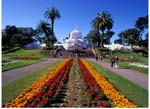 (Kevin J. Frest (c) Conservatory of Flowers/Friends of Recreation and Parks) The Conservatory of Flowers in full bloom (Catherine Lyon-Labate (c) Conservatory of Flowers/Friends of Recreation and Parks) The Conservatory glows at night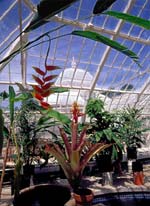 (Kevin J. Frest (c) Conservatory of Flowers/Friends of Recreation and Parks) View from the inside out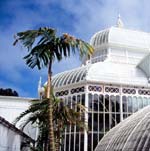 (Kevin J. Frest (c) Conservatory of Flowers/Friends of Recreation and Parks) View from the outside in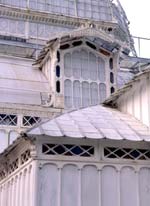 (Kevin J. Frest (c) Conservatory of Flowers/Friends of Recreation and Parks) The painted exterior before restoration began (Ted Kurihara (c) Conservatory of Flowers/Friends of Recreation and Parks) Restoration begins (Ted Kurihara (c) Conservatory of Flowers/Friends of Recreation and Parks) Interior detail during restoration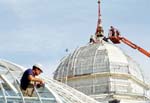 (Kevin J. Frest (c) Conservatory of Flowers/Friends of Recreation and Parks) Restoring the roof (Kevin J. Frest (c) Conservatory of Flowers/Friends of Recreation and Parks) A lily pond before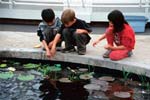 (Kevin J. Frest (c) Conservatory of Flowers/Friends of Recreation and Parks) A lily pond after (The Portico Group) Floorplan |
© 2003 ArchNewsNow.com